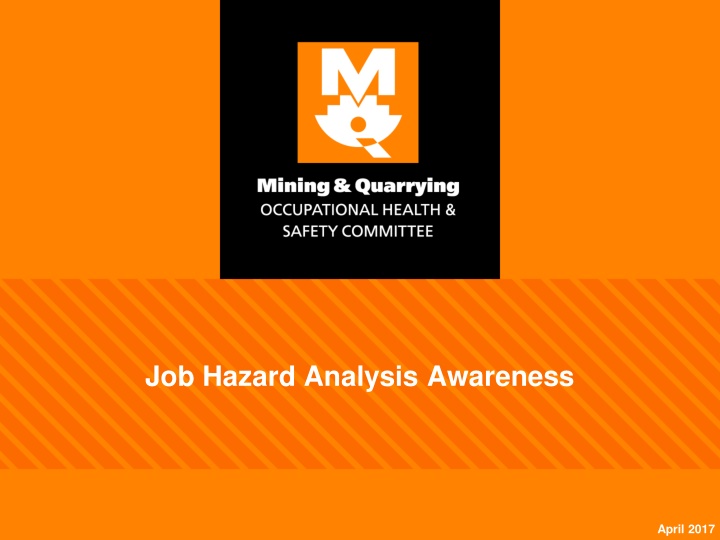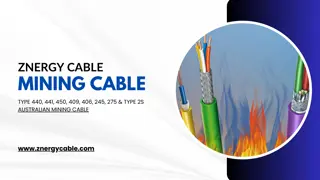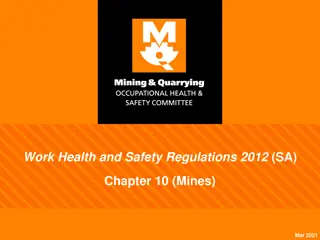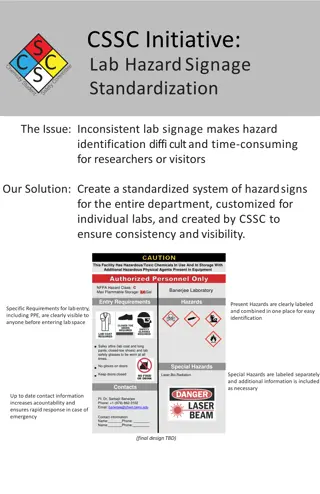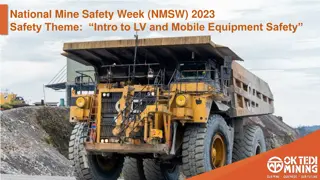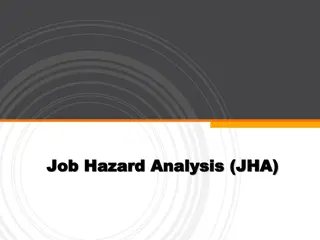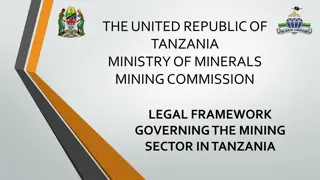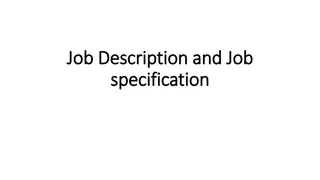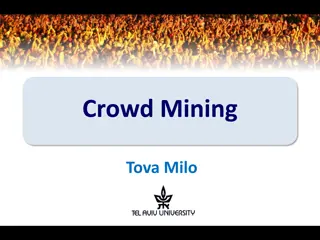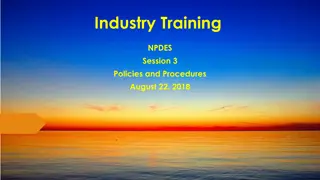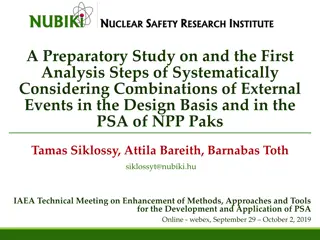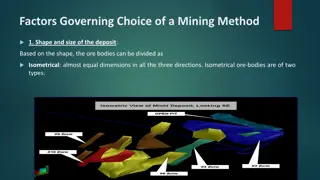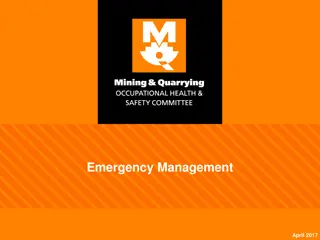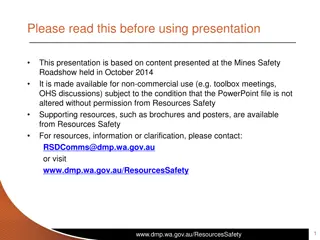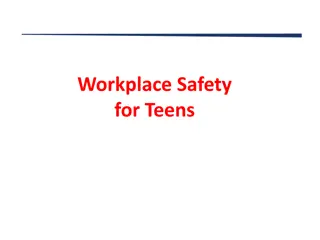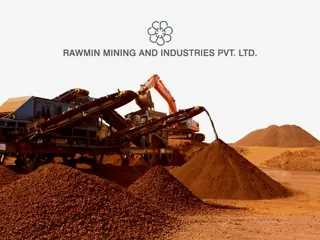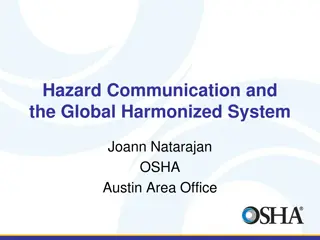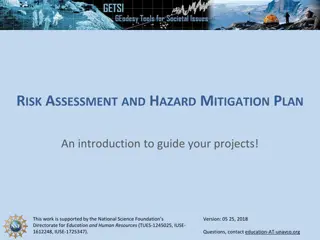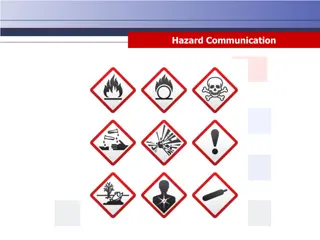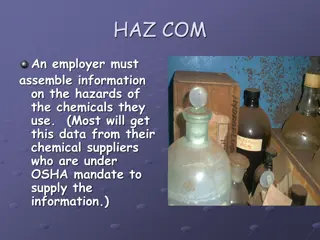Enhancing Workplace Safety: Job Hazard Analysis Awareness in Mining and Quarrying
This workplace safety presentation, funded by the Mining and Quarrying Occupational Health and Safety Committee, emphasizes the importance of job hazard analysis in promoting health and safety in the mining and quarrying industry. The content highlights the need for thorough risk assessments to prevent accidents and ensure a safe work environment for all employees.
Uploaded on Sep 27, 2024 | 2 Views
Download Presentation

Please find below an Image/Link to download the presentation.
The content on the website is provided AS IS for your information and personal use only. It may not be sold, licensed, or shared on other websites without obtaining consent from the author.If you encounter any issues during the download, it is possible that the publisher has removed the file from their server.
You are allowed to download the files provided on this website for personal or commercial use, subject to the condition that they are used lawfully. All files are the property of their respective owners.
The content on the website is provided AS IS for your information and personal use only. It may not be sold, licensed, or shared on other websites without obtaining consent from the author.
E N D
Presentation Transcript
Job Hazard Analysis Awareness April 2017
The Mining and Quarrying Occupational Health and Safety Committee Promoting Work Health and Safety in the Workplace This workplace industry safety presentation is developed and fully funded by the Mining and Quarrying Occupational Health and Safety Committee (MAQOHSC). ISBN 978-1-925361-41-4 2
Disclaimer IMPORTANT: The information in this presentation is of a general nature, and should not be relied upon as individual professional advice. If necessary, legal advice should be obtained from a legal practitioner with expertise in the field of Work Health and Safety law (SA). Although every effort has been made to ensure that the information in this presentation is complete, current and accurate, the Mining and Quarrying Occupational Health and Safety Committee, any agent, author, contributor or the South Australian Government, does not guarantee that it is so, and the Committee accepts no responsibility for any loss, damage or personal injury that may result from the use of any material which is not complete, current and accurate. Users should always verify historical material by making and relying upon their own separate inquiries prior to making any important decisions or taking any action on the basis of this information. 3
Creative Commons This work is licenced under Creative Commons Attribution Non Commercial 4.0 International Licence. The licence is available to view at http://creativecommons.org/licenses/by-nc/4.0/ This creative commons licence allows you to copy, communicate and or adapt our work for non-commercial purposes only, as long as you attribute the work to Mining and Quarrying Occupational Health and Safety Committee and abide by all the other licence terms therein. 4
Objective The objective of this session is to explain: What a Job Hazard Analysis (JHA) is When a JHA should be used The benefits of a JHA JHA roles and responsibilities The JHA process How to fill out a JHA JHA requirements. 5
JHA What is it? A JHA is a simple risk management tool used to ensure a job or task is performed safely. It is a more detailed analysis of hazards and risks than a Take 5 or workplace inspection. It is written by the people performing the task (team risk assessment). Is it reviewed by supervisor(s) prior to the commencement of work.
JHA Terminology Hazard Anything which has the potential to cause harm. Control Anything that helps to reduce or eliminate the risk presented by the hazard. Risk Combined measure of the consequence (severity of harm) and the likelihood presented by the hazard. 7
Levels of Risk Assessment Take 5 or Workplace Inspection Level 1 JHA Level 2 Formal Risk Assessment Level 3 8
Benefits of JHAs Improves job planning Identifies hazards associated with task Identifies controls for managing hazards - thereby eliminating or minimising risk of harm Provides a review process to ensure line management are aware of moderate and high risk tasks being performed Assists employees to understand risk management Demonstrates a structured process for managing risk Keeps people safe. 9
JHA - When must one be done? When a Take 5 or workplace inspection identifies hazards that are complex, high risk or can t be readily controlled When there is no written procedure or safe work procedure for the task When work permits are required (e.g. confined space) Where there are deviations from standard work practices If new hazards are identified or the task changes When existing risk controls are unclear As the first step in developing a safe work procedure. 10
JHA Roles and Responsibilities Supervisors Confirm tasks that require JHAs Discuss JHA requirements at pre-start meetings Assign a competent JHA team leader to lead the development of JHAs Review the JHA prior to tasks commencing Involve managers where necessary to review JHAs. 11
JHA Roles and Responsibilities Team members Identify tasks that require JHAs Participate in the development of JHAs Follow JHAs Stop work if the task requires steps not covered in the JHA. 12
JHA Process Step 1 : Complete task details Step 2 : Decide job steps Step 3 : Identify hazards Step 4 : Identify existing controls Step 5 : Identify risk rating Step 6 : Identify and implement additional controls Step 7 : Approval and review. 13
Number of steps for each job or task How are the number of steps required for each task determined? We will use the example of changing a flat tyre showing too many steps, too few steps and about the right number of steps 14
Changing a Tyre Too Many Steps 1. Pull off road 9. Open boot 2. 10. Remove jack Put car in park 3. Apply hand brake 11. Remove spare tyre 4. Activate emergency hazard lights 12. Etc .. 5. Open door 6. Get out of car 7. Walk to boot 8. Put key in lock 15
Changing a Tyre Too Few Steps 1. Park car 2. Take off flat tyre 3. Put on spare tyre 4. Drive away 16
Changing a Tyre Just Right 1. Park car, apply brake 2. Remove jack and tyre from boot 3. Loosen wheel nuts 4. Jack up car 5. Remove tyre 6. Fit new tyre 7. Jack down car 8. Tighten wheel nuts 9. Store tyre and jack 17
JHA Key Points! 3 Key points! 1. Break task into STEPS 2. Identify HAZARDS 3. Implement CONTROLS to reduce or eliminate the RISK 18
JHA Requirements The JHA must be read, understood and signed by all persons doing the job before starting work. Supervisor must review and sign the JHA before work commences. All personnel, and both supervisors, must sign on to the JHA for a job that takes longer than one shift. Area manager must review the JHA where the risk rating is assessed as high or above. If the job changes, or the nature of the hazards change, then the JHA should also be changed. Completed JHAs should be retained by each department for future reference. Higher level of risk assessment required if uncertain of extent of risk or adequacy of controls. 19
JHA Requirements The JHA must be developed by two or more people involved with the task. All personnel working on the task must have access to the JHA. A JHA can remain valid for a maximum of 30 days from the approval date (providing that the conditions do not change). The same JHA can not be used more than once. Ideally if a JHA is going to be used more than four times a year for the same task then a safe work procedure should be developed. The work site should be visited to help identify any potential hazards and ensure that the task is understood by those developing the JHA. The hierarchy of controls should be used with the aim of using the strongest and most effective controls. 20
JHA Important Points JHAs do not require as much detail as a safe work procedure (e.g. photos / diagrams). They are a tool for: Breaking a task into steps to understand the hazards and implement effective controls The development or review of a safe work procedure Implementing effective controls for hazards introduced when work practices / conditions change. Workgroup involvement provides ownership! Your JHA can keep YOU safe at work. 21
Further Assistance MAQOHSC Work Health and Safety Specialists are available to provide further on-site support and assistance on all Work Health and Safety matters. MAQOHSC Work Health and Safety Specialists can be contacted via our online support request form available on our website at www.maqohsc.sa.gov.au or email maqohsc@sa.gov.au. Work Health and Safety Legislation, Codes of Practice, fact sheets, Health and Safety Representatives (HSR) information and guides can be found at the following websites: SafeWork SA www.safework.sa.gov.au or call 1300 365 255 Safe Work Australia www.safeworkaustralia.gov.au or call 1300 551 832 22
